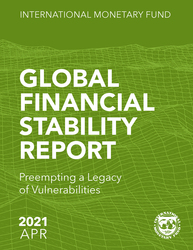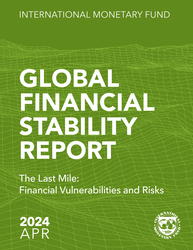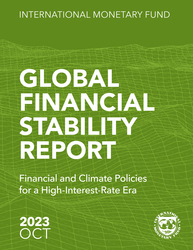
Global Financial Stability Report, April 2021:Preempting a Legacy of Vulnerabilities
Extraordinary policy measures have eased financial conditions and supported the economy, helping to contain financial stability risks.
READ MORE...
Volume/Issue:
Volume 2021
Issue 001
Publication date: April 2021
ISBN: 9781513569673
$50.00
Add to Cart by clicking price of the language and format you'd like to purchase
Available Languages and Formats
| English |
Topics covered in this book
This title contains information about the following subjects.
Click on a subject if you would like to see other titles with the same subjects.
Banks and Banking , Finance , International - Economics , global financial stability , financial market , commercial real estate , leverage , macro-financial stability , financial recovery
Also of interest
Summary
Extraordinary policy measures have eased financial conditions and supported the economy, helping to contain financial stability risks. Chapter 1 warns that there is a pressing need to act to avoid a legacy of vulnerabilities while avoiding a broad tightening of financial conditions. Actions taken during the pandemic may have unintended consequences such as stretched valuations and rising financial vulnerabilities. The recovery is also expected to be asynchronous and divergent between advanced and emerging market economies. Given large external financing needs, several emerging markets face challenges, especially if a persistent rise in US rates brings about a repricing of risk and tighter financial conditions. The corporate sector in many countries is emerging from the pandemic overindebted, with notable differences depending on firm size and sector. Concerns about the credit quality of hard-hit borrowers and profitability are likely to weigh on the risk appetite of banks. Chapter 2 studies leverage in the nonfinancial private sector before and during the COVID-19 crisis, pointing out that policymakers face a trade-off between boosting growth in the short term by facilitating an easing of financial conditions and containing future downside risks. This trade-off may be amplified by the existing high and rapidly building leverage, increasing downside risks to future growth. The appropriate timing for deployment of macroprudential tools should be country-specific, depending on the pace of recovery, vulnerabilities, and policy tools available. Chapter 3 turns to the impact of the COVID-19 crisis on the commercial real estate sector. While there is little evidence of large price misalignments at the onset of the pandemic, signs of overvaluation have now emerged in some economies. Misalignments in commercial real estate prices, especially if they interact with other vulnerabilities, increase downside risks to future growth due to the possibility of sharp price corrections.
Copyright © 2010 - 2025
Powered by:
AIDC



